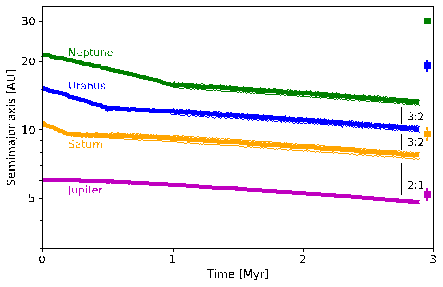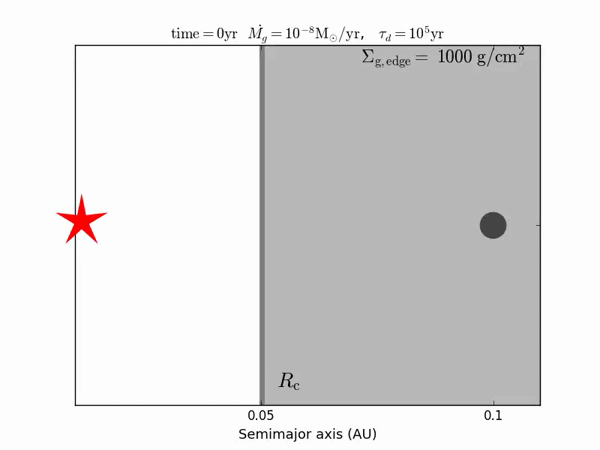At the beginning of the birth of the solar system, the gas molecular cloud in the interstellar space collapsed, and the central part formed the sun. The residual material rotated around the star to form a flat protoplanetary disk. This period is also known as the gas disk period of the solar system. The planets grew in the planetary disk, interacted with the gas in the disk, and their orbits gradually rounded and migrated inward.

Scientists try to find out the growth process of the solar system by studying the dynamic changes of Jupiter, Saturn, Neptune and other celestial bodies. The reporter learned from Zhejiang University that researcher Liu Beibei of the school of physics of Zhejiang University, together with Professor Raymond of the University of Bordeaux in France and Professor Jacobson of Michigan State University in the United States, put forward a new model for the orbital evolution of giant planets in the solar system. They pointed out that in the early stage of the formation of the solar system, the protoplanetary disk was evaporated by solar light, and the gas in the disk dissipated from inside to outside, which induced the remodeling of the giant planet's orbit and caused dynamic instability. Relevant research results were published in the journal Nature recently.
The new model shows that the orbital instability of giant planets occurs earlier
The orbital evolution of giant planets has a far-reaching impact on the evolution of other planets, satellites and small celestial bodies, including the earth, as well as the origin of life on the earth and the habitability of the earth.
Scholars believe that during the period of the gas disk of the solar system, the four giant planets of the solar system, such as Saturn, Jupiter, Uranus and Neptune, enter the orbital resonance state through migration, that is, the revolution period of adjacent planets is an integer ratio. At present, the orbit distribution of the four giant planets is more open, and the giant planets have broken away from the original resonance state. The orbit of the giant planets may have experienced drastic changes in dynamics.
"Imagine a Viaduct with normal traffic flow. If a vehicle collides and rear ends, the driving order of the whole viaduct will be disrupted." Liu Beibei said.
At present, the most popular model to describe the evolution of giant planets in the solar system is the nice model. According to the nice model, the orbital instability of giant planets occurred hundreds of millions of years after the birth of the solar system. At that time, the gas in the protoplanetary disk dissipated, and the giant planets interacted with the external stellar disk (composed of stars with a diameter of several kilometers to hundreds of kilometers) to continuously exchange orbital energy, which finally made the planets get rid of the resonance bondage and lead to dynamic instability. Because the energy exchange in this process is very slow, the orbital instability belongs to the "late instability" hundreds of millions of years after the birth of the solar system.

Liu Beibei's team proposed that previous studies ignored the reverse force of gas on the planet in the process of gas disk dissipation. The evolution of planetary orbits can be explained by the dissipation of gas disks, which is not considered in the nice model.
"In the late stage of the evolution of the gas disk, the high-energy photons radiated by the sun directly hit the planetary disk, and the strong light pressure first dispersed the gas close to the sun, and a hollow structure appeared in the planetary disk. Subsequently, the light pressure gradually dissipated the remaining gas in the disk from inside to outside, and the mass of the planetary disk decreased with the outward expansion of the inner boundary of the disk. This process is called photoevaporation of the planetary disk." Liu Beibei said that at this time, the sun is like a giant hair dryer, constantly "blowing" away the gas in the plate.

Through theoretical calculation, Liu Beibei's team found that due to the rapid dissipation of gas at the inner boundary of the original gas disk, the planet is subjected to outward gas force, which is quite different from the inward force on the planet at other positions of the original gas disk. When the inner boundary of the gas disk expands outward from light-induced evaporation, the planets that originally migrated inward change the direction of motion and move outward together with the inner boundary. Due to their different masses, giant planets migrate outward at different speeds, breaking the original orbital resonance and causing dynamic instability.
"The team's research shows that the dynamic instability caused by this process follows the dissipation of the gas disk and occurs about 5 million to 10 million years after the birth of the solar system. Unlike the nice model, the orbital instability of giant planets in our model occurs earlier." Liu Beibei said.

Other celestial bodies in the solar system provide evidence for the new model
The above paper proposes that the dynamic instability of the orbits of the early giant planets led to the large-scale orbital changes of the first four giant planets and another ice giant star when the gas disk dissipated. The ice giant star was thrown out of the solar system after touching Jupiter, reaching the final stable orbital distribution of the four giant planets, which is consistent with the current observation results.
Liu Beibei said that the unstable dynamics of giant planets will break the original calm of the solar system. Their strong gravitational disturbance forces the surrounding small celestial bodies to constantly collide with other planets and satellites, leaving meteorite craters on the surface of the stars. Lunar craters have a wide age distribution. According to the age distribution of lunar craters, asteroid impact events decay naturally over time, which is also consistent with the early instability model proposed by the team.
In addition, the orbits of earth like planets also support the model of Liu Beibei's team. According to the observation, the primitive earth was formed in the protoplanetary disk stage, and finally grew up within 30 million to 100 million years after the birth of the solar system. If the orbital instability of giant planets occurs before the complete formation of the earth, the orbital turbulence of giant planets has the probability to trigger a large collision event, which will induce the primitive earth to collide with a celestial body the size of Mars, and gradually form the current Earth Moon system.
"As expected by the nice model, the orbital instability of giant planets occurred after the formation of the earth, and the earth could not become today's earth." Liu Beibei believes that the early dynamic instability is more in line with the records of asteroid impact time from other celestial bodies in the solar system. The new model can also better explain the mass and orbital configuration of the subsequent earth like planets, which are different from the traditional model.
"This model is likely to be a missing element in the theory of solar system evolution. The article is novel and of great significance." Reviewers of the journal Nature commented on the study. Liu Beibei said that in the future, the team will further explore the impact of the orbital evolution of giant planets on the formation of the earth and the origin of water.